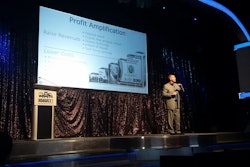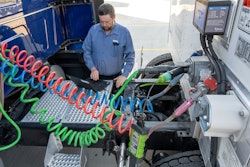We’ve got the best house in a run-down neighborhood.
That was the analogy posed by Bill Strauss, senior economic advisor at the Federal Reserve Bank in Chicago, made on Monday at Heavy Duty Aftermarket Dialogue in Las Vegas.
Strauss presented a Blue Chip Economic Indicators Forecast that showed the U.S. with a GDP gain of 2.5 percent for 2015, 2016 and 2017. Of the 13 nations listed, India had the most impressive GDP gains of 7.4 percent, 7.6 percent and 7.7 percent for 2015-2017 respectively.
China had the second best GDP figures with 6.9 percent, 6.4 percent and 6.3 percent for 2015-2017 respectively. However, Strauss and Dr. Bob Dieli, president and founder of RDLB, both agreed during an economic panel that China’s growth is questionable.
“It’s a control economy,” Strauss cautioned. “As far as them moving into a market economy, it’s far from it. It’s opaque, in terms of what they’re willing to share with the rest of the world.”
Strauss explained that there were two unexpected jolts to the U.S. economy: the collapse of the energy market vis-à-vis a massive drop in oil prices and a surge in the value of the U.S. dollar.
Foreign investors concerned with their own markets have turned more and more to the U.S. for their investments, Strauss said.
“We began to see money pouring in for investment purposes,” Strauss told the audience. “The dollar went up 17.2 percent over the past 16 months.”
While the U.S. unemployment rate is at 5 percent, about half that of its peak during the Great Recession, Strauss said that unimpressive wages make it appear as if the job market has remained stagnant.
“Job growth has been great,” he said. “But people don’t feel that way, and I think naturally so. Wages and benefits continue to increase at a very slow pace.”
Strauss explained that slow productivity growth was to blame for relatively stagnant income. He expects industrial productivity to increase this year, but that rise will still be below its historical growth.
Strauss reported that though manufacturing has dropped off, there has been encouraging news with an uptick in new housing starts and record auto sales.
During a panel discussion, Dieli offered discouraging news about aftermarket parts.
“They don’t want to buy them,” he said. “I’m not joking. It’s willingness and ability. They have the ability, and they’re not buying them.”
Panel discussion leader Rick Dauch, president and CEO of Accuride, asked if a drop in class 8 truck sales could be an ominous indicator for the aftermarket parts industry.
“No, we’re just seeing one of these cycles,” Strauss said, adding that there’s a very low probability for recession.
Dieli said that a decline in truck sales is owed to supply issues.
“You can only sell them so many trucks,” he said.
Regarding the Federal Reserve’s plans for the U.S. market in 2016, Strauss said its taking a more conservative approach.
“We’re basically moving down the road at half speed,” he said. “The Fed is not braking—just taking its foot off the gas.”











